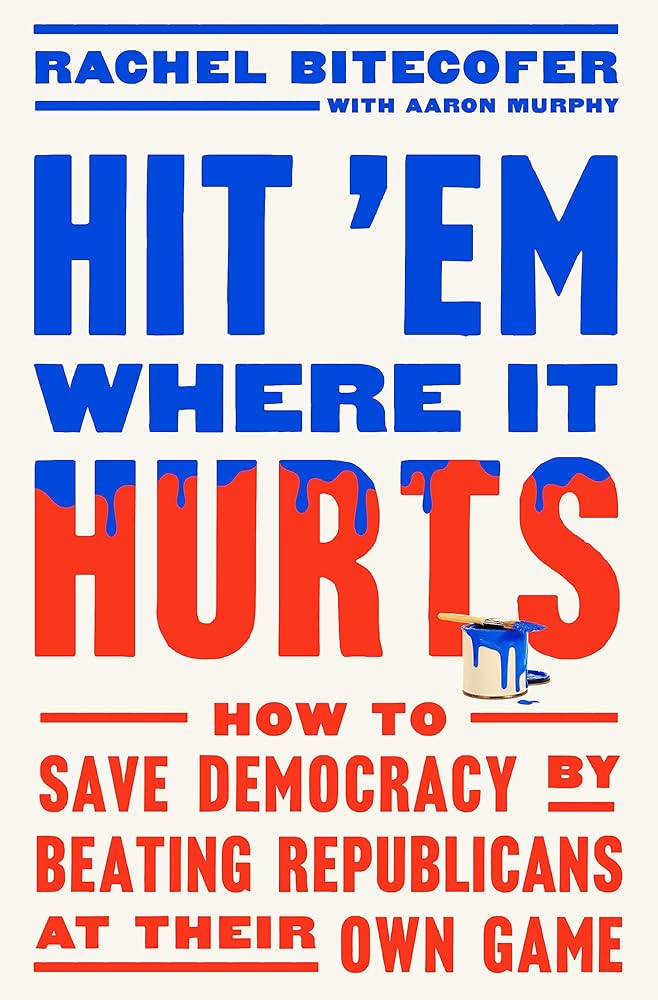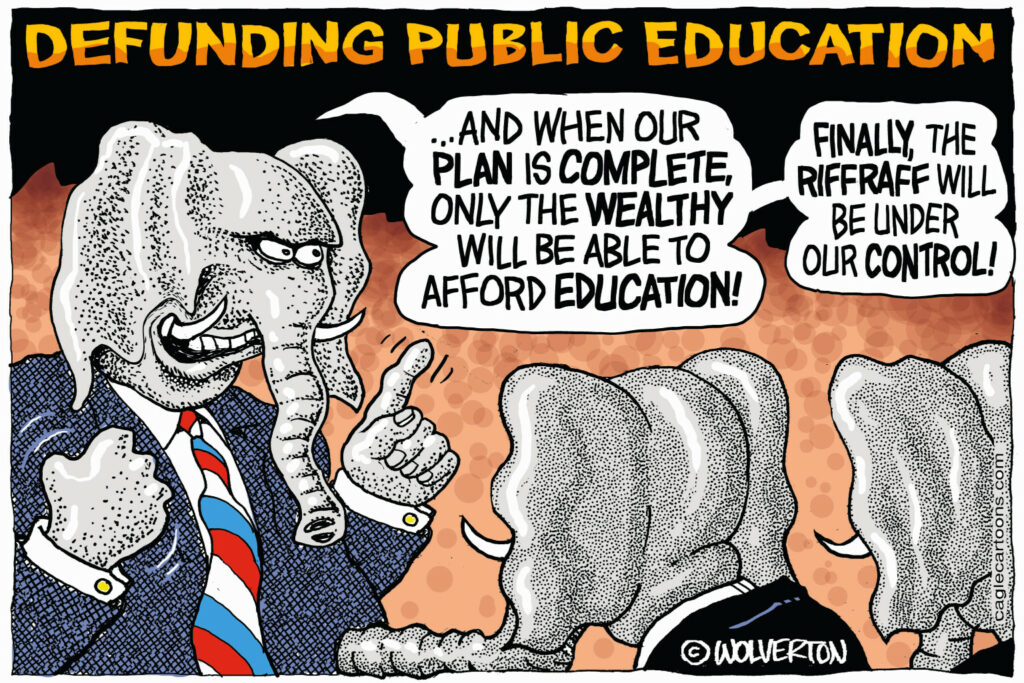By Rachel Bitecofer

Rachel “The Doc” Bitecofer is the author of the new book Hit ‘Em Where It Hurts: How to Save Democracy by Beating Republicans at Their Own Game. Below is Chapter 8: Stronger Messaging in Seven Steps
With democracy on its deathbed, I hope you’re wondering what we can do about it. What can we start doing right now to make the Democratic Party—the party of the people—tougher, smarter, and more efficient heading into future elections? And to win those elections? The rest of this book is my response.
First, consider all elections, big and small, as battles in a much larger and far more consequential electoral war whose victors will determine the future of this nation. The Republican Party certainly thinks of them that way. And while this electoral war remains a cold war of ideologies, never forget some on the far right are openly advocating for—and using—violence. We saw it on full display even before January 6, 2021. You cannot afford to sit out unless you are one of those mob insurrectionists. Politics is no longer a “season” most Americans have to put up with every other autumn; it is a 24/7 tug-of-war over the future of democracy. Even if you don’t want a war with the Republican Party, they’re already at war with you.
Second, understand the strategies and tactics of today’s GOP. They have a decades-long head start in fighting this war. And the GOP has given us plenty more to work with after Donald Trump took over as their undeniable leader.
If you’ve come along with me this far, you already have a pretty good grasp of how Republicans fight and how they win. We need to use every tool at our disposal—our new understanding of human behavior, the news media, political infrastructure, and control of the narrative—to tear up our old playbook and fight fire with fire.
As the great military strategist Sun Tzu advised twenty-five hundred years ago, preparation is the most important step before battle. The same goes for the art of electoral war. We’ve got to acknowledge our weak spots, know the opposition’s strengths and shortcomings, and understand every element of their strategy.
Third, let’s start by picking the lowest-hanging fruit, which is improving Democratic messaging. Now that we understand what we’re up against and where we’ve fallen short let’s win back the Message. We have no choice with our freedom, health, wealth, and safety on the line. This advice doesn’t apply just to card-carrying Democrats, by the way. Anyone concerned about America’s future can use stronger messaging to help save democracy.
1. Ride For The Brand
In the old days of the American West (and in some places still today), cowboys were said to “ride for the brand,” meaning they focused their time and attention only on the cattle bearing the brands of the livestock owners who paid them. Those brands were easy-to-identify symbols burned into the hides of calves, permanently scarring the animals so ranchers could easily find, sort, and separate them on the open range.
In politics, branding is what we end up with when political messaging is effective, for better or worse. It results from a deliberate attempt to get voters to believe something about a particular politician or political idea. Word association is a good way to find and test a political brand. What’s the first word to come to mind when you think of the Republican Party? Ron DeSantis? Congress? Joe Biden?
MAGA Lyft Driver
One of the most familiar branding successes in American politics shaped a strange conversation I had with a Lyft driver a few years back. Whenever I book a trip with a chatty rideshare driver, I like to ask a question or two about politics to see where the conversation goes. There’s nothing scientific about these informal, one-on-one focus groups, but they usually yield interesting perspectives from strangers around the country.
“I respect Donald Trump,” the driver, who spoke broken English and happened to be an immigrant, happily told me as he navigated the streets of downtown D.C.
“But what do you think of him as president?” I asked with my typical poker face.
“He’s a wonderful president,” he replied. “A good businessman. Successful!” Then the driver looked at me in the rearview mirror and, with a chuckle, imitated the Apprentice tagline: “You’re fired!”
I don’t need to tell you that Donald Trump is not and never was a particularly good businessman, do I? The failures of his myriad ventures—from fraudulent companies to sham universities to mailorder steaks—have been documented for decades. The man bankrupted a casino, for heaven’s sake! It is an objective fact that Trump has driven businesses into the ground, screwing countless clients, contractors, and American taxpayers in the process.
But millions of Americans immediately think “business success” or “art of the deal” when they hear the name Donald Trump. That’s because Trump’s carefully cultivated political brand was more powerful than reality. Despite all of Trump’s failures, and despite copious news coverage of those failures, his brand as a successful tycoon—as a cutthroat dealmaker, as a problem solver—is stronger.
This brand crystallized in 2004 when NBC gave Trump a starring role in its hit “reality” T.V. show. The Apprentice not only boosted Trump’s household name recognition and celebrity status, it completed a made-up circuit that the man was his T.V. show character: an embodiment of power, wealth, confidence, and success. This tightly controlled illusion was so effective that it was seared into the imagination of my Lyft driver, where it remained a fantasy twenty years later. Trump’s brand as a successful businessman was as permanent as an actual cattle brand.
Negative partisanship
Republicans have an endless supply of dishonest brands for Democrats. The old Republican Party branded Democrats as “tax and spend liberals” who reject the conservative values of smaller government and low taxes. But today’s Republican Party is painting a much more sinister brand for Democrats, convincing a whole lot of other Americans that all Democrats are woke, pro-crime socialists who are racist against white people and who want to groom children into sexual deviants. Of course, this isn’t true, but remember that for today’s GOP, inconvenient details like truth no longer matter. This is also strategic for Republicans; it’s negative partisanship! Their branding motivates GOP voters and leaners, pushing independent swing voters away from supporting Democrats.
But how effectively do Democrats brand Republicans? How do they brand themselves? This is yet another vulnerability for Team Blue because effective political branding doesn’t happen without effective messaging, and we know our problem. It also won’t happen unless Democrats embrace basic marketing principles. Democrats are good at governing and making important policy decisions but just kind of suck at marketing.

Sure, Democrats and Republicans have some brands for themselves, but which of them actually resonate with the electorate? If you were to ask all Americans the first thing they think of when they hear the word “Democrat,” what would be the most common answer? Would it be something Democrats are proud of? Would it help them win elections? Would it be accurate? If the past is prologue, probably not.
So when I say step 1 is “Ride for the Brand,” I mean Democrats should rebrand themselves with a single guiding value—one symbolic word—and stick to it, using it whenever possible as a guiding star for their political messaging. This word should accurately reflect the Democrats’ enormously complex and diverse party under one emotive umbrella, frame the stakes of every election, and be shaped by a negative partisanship strategy. And the results of the 2022 midterms already tell us what that word ought to be.
2. Rebrand Both Parties With F-Words
Here are two truths that many Americans simply will not believe, thanks to the GOP’s success in branding Democrats and themselves:
• Today, the Democratic Party is the only political party truly fighting for and preserving American freedom.
• Though it brands itself with patriotic images and language, today’s Republican Party hates freedom; they want fascism.
Democrats must take back the most powerful f-words in American politics by rebranding themselves as the party of freedom and the Republicans as the party of fascism. Democrats must make a clear, accurate case that every election, as well as almost every plan and piece of legislation in the Republican Party’s agenda, is ultimately about keeping or losing freedom.
The Republican agenda is making that challenge easier by the day as long as Democrats frame the stakes for voters. For example, outlawing drag shows and gender-affirming medical care isn’t just an LGBTQ issue; it is an attack on freedom. Banning books doesn’t protect children; it takes away their freedom! “Raising questions” about a free and fair election with no evidence of fraud isn’t just entertaining a conspiracy theory; it’s an attack on our freedom to choose our government.
The Supreme Court’s 2022 Roe v. Wade reversal angered and motivated so many Americans because the decision allowed states to outlaw specific medical procedures. No, it fired up Democratic voters because of something much deeper and more horrifying, resonating in every corner of our country. The Supreme Court’s decision meant the freest people in the world suddenly had no control over their bodies or medical choices. That argument stuck with voters when some Democratic candidates framed the stakes, starkly and accurately, as a loss of their own freedom. It was powerful stuff. And as we’ll see soon, it worked well politically for most Democrats who used it.
Gavin Newsom understood the power of messaging the Republican attack on freedom, too. On Independence Day in 2022, he launched an ad in Florida trolling Republicans about their efforts to undermine American democracy. The California governor, then rumored to be considering a presidential candidacy, called his thirty-second T.V. spot “Florida Freedom.”
“Freedom? It’s under attack in your state. Republican leaders? They’re banning books, making it harder to vote, restricting speech in classrooms, and even criminalizing women and doctors. I urge all of you living in Florida to join the fight or join us in California, where we still believe in freedom: Freedom of speech. Freedom to choose. Freedom from hate. And the freedom to love. Don’t let them take your freedom.”
For no good reason other than volume, discipline, and repetition, the political Right has laid claim to the value of freedom—simply because Republicans branded themselves with it. Everyone can and should own freedom as a deep-rooted American value, especially after we’ve worked so damn hard and shed so much blood to guarantee it. But now that the Republican Party is overtly yanking away our freedoms, Democrats get to own freedom as their political brand.
“It has frustrated me that Republicans love to cloak themselves in this blanket of freedom and feel as though they own it somehow, when in fact what they are selling to the people of Pennsylvania or the American people, really isn’t freedom at all,” the then-candidate Josh Shapiro said during his successful 2022 run to become governor of Pennsylvania. What Republicans actually want, Shapiro added, is “far bigger government and more control over people’s everyday lives.“

Let’s consider that our cue, then, is for Democrats to reframe and redefine freedom when Republicans try to use it—or worse, when they claim only they own it.
• If a MAGA Republican claims a face-mask mandate during a worldwide pandemic is a violation of her freedom, reframe her objection as a violation of your freedom to not get sick from the shit coming out of her germy face.
• If a MAGA Republican claims losing his assault rifle is a violation of his freedom, reframe his objection as a violation of a third grader’s freedom to go to school without getting murdered by an assault weapon.
Whenever possible, Democrats should center their branding and messaging—especially about the work and intentions of the GOP—on the maypole of American freedom, the growing threat today’s Republicans pose to it, and how it directly threatens voters’ health, wealth, and safety.
The Republican Party’s definition of freedom is a very narrow one—one befitting a time when politics was the exclusive domain of wealthy, educated, straight, mostly Christian white men. There’s another f-word for forcing that narrow definition on everyone else: “fascism.” And that should be the Democratic Party’s new brand for the GOP.
Every election from this point forward boils down to an uncomplicated, fundamental choice between Democratic Party freedom and Republican Party fascism, and it falls on Democrats and their messaging to frame it that way.
3. Less Defense, More Counteroffense
Politico published a leaked draft of the Supreme Court’s decision overturning Roe v. Wade on the evening of May 2, 2022. The following day, the White House released a wordy statement from President Biden outlining “three points about the cases before the Supreme Court,” detailing how the president had asked his advisers to “prepare options for an Administration response” and a ho-hum warning that “it will fall on voters to elect pro-choice officials this November.” The Democratic National Committee also responded with the political equivalent of “get off my lawn, kids!”—a 147-word statement that ended with “we will fight back with everything we have, and Republicans will have to answer for their party’s relentless attacks on Americans’ rights.”
End womens’ freedom
Of course, the decision to end women’s freedom—and Politico’s early preview of it—caused a national uproar among Democrats and millions of other concerned Americans who don’t even identify with a political party. Progressive politicians, candidates, and organizations shared furious opinions and statements about the historic decision and the court’s legitimacy. But did the Democratic Party immediately provide a cohesive, unified message strategically designed to put Republicans on defense? No. Not even close.

If there was any deep, strategic, poll-tested wordsmithing by Democratic leaders before or after the overturning of Roe v. Wade, a decision the Left had anticipated for years if not decades, the rest of us didn’t get the memo! There was no centralized messaging plan akin to Frank Luntz’s “New American Lexicon,” widely distributed to Democrats, detailing words that work with clear messaging guidance and advice. So on May 4, two months before launching his “Florida Freedom” ad, Gavin Newsom got feisty about the state of the Democratic Party during a news conference in Los Angeles.
“Where the hell is my party?” the governor fumed, flanked by Planned Parenthood activists. “Why aren’t we standing up more firmly? More resolutely? Why aren’t we calling this out? Where is the counteroffensive in the Democratic Party?”
Ah, the counteroffensive. Democrats are used to playing defense. But again, you don’t score many touchdowns playing defense. A counteroffensive message puts your opponent on defense on an issue that hurts them politically. When the Republican Party got behind Glenn Youngkin in Virginia in 2021, they didn’t wait for Democrats to criticize Youngkin on his weak-ass vision for public education. No, the Republicans executed a counteroffensive strategy: They put Democrats on defense— on their issue of education—with critical race theory. Democrats should get much more comfortable with this rougher, tougher play.
So what would a Democratic counteroffensive to the Supreme Court’s decision have looked like? Justice Clarence Thomas gave us the perfect opportunity to play counteroffense when he wrote his concurring opinion. Justices “should reconsider all of this Court’s substantive due process precedents,” Thomas wrote, referring to previous court decisions that allowed contraceptives and same-sex marriages. In stronger words, the Supreme Court’s conservative majority isn’t just coming after abortion rights; they are coming after all rights you and I take for granted!
To wit, here’s the counteroffensive response I would have suggested:

Republicans have stripped American women of their freedom.Will they come for YOURS next?
Note how I didn’t bother getting specific about the case itself, Justice Thomas and the decision-making process of the Supreme Court, or the Republicans’ decades-long effort to game the system and stack the court with antiabortion justices. As we’ve already established, most Americans don’t pay enough attention to civics for those kinds of distracting details. Please keep it simple and make your audience feel your message in the gut rather than merely hear it.
The economy
Similarly, suppose Republicans complain about how crappy our economy is and blame a Democratic president for it. In that case, the Democrats’ response shouldn’t be to explain exactly why the economy isn’t crappy with academic reasoning and numbers that few people understand. That’s exactly what Republicans want us to do. When we take their bait, we put ourselves on defense. We wander in the weeds, wondering why nobody’s hearing us. Anyone listening certainly isn’t hoping for an academic explanation, no matter how accurate or eloquent it may be.
No, the Democratic counteroffensive response to a crappy economy should be to talk about how the Republican Party destroyed the American middle class using their “voodoo” economic plan known as Reaganomics while marketing Bidenomics as the cure. Showing and reminding voters that they cannot trust Republicans with their money is a counteroffensive strategy on the economy, one of the most important issues to voters in every election cycle.
4. Take Credit, Give Blame
In Congress, the Republican Party has essentially given up on policymaking altogether and has instead shifted its entire focus to winning elections, messaging their culture war, and grievance politics. In both the Senate and the House, Republicans proudly brand themselves as obstructionists tasked with preventing Democratic majorities from doing the work of the people.
“One hundred percent of [the Republican Party’s] focus is on stopping this new administration,” Mitch McConnell admitted in May 2021 when talking to reporters about Joe Biden’s months-old presidency. The Senate minority leader’s comment echoed another infamous remark he made in 2010 about the GOP’s top political priority being “to deny President Obama a second term.”

Senator Ron Johnson took the new Republican strategy of obstructing over legislating a step further when he appeared on Fox News in the fall of 2021. “I hope for Democrat gridlock,” the Wisconsin Republican told Fox’s Maria Bartiromo with a straight face. “Often in Washington, D.C., gridlock is the better alternative, but when it’s Democrat gridlock, pray for it.”
I point this out because the Republican Party’s strategy of embracing political brokenness presents another opportunity for stronger Democratic messaging: taking credit for being the one party that delivers tangible results for America while assigning blame to the party whose stated goal is to stand in the way. Doing this effectively requires delivering partisan messages, which too many elected Democrats— especially ones in swing states or traditionally red states—shy away from. Purposefully or not, Democrats often bleach partisanship out of their messaging, doing themselves no favors.
“If you’re on Medicare and need insulin,” a Democratic U.S. senator tweeted in late 2022, “it’s capped at $35 starting in 2023.” Democrats in Congress included the insulin price cap in their Inflation Reduction Act of 2022, which not a single Republican member of Congress voted for. So, while there was nothing inaccurate with our Democratic senator’s public service tweet, the message missed a critical branding opportunity. Instead, the message should have been this: “Because Democrats capped insulin at $35, American seniors no longer have to go hungry to pay for the medicine they need to live.” Our brand is up. The Republican brand is down.
After Congress passed the American Rescue Plan Act along party lines in 2021, one Democratic governor hailed the achievement as a “once-in-a-generation opportunity” and a “truly collaborative effort.” Though his press release featured celebratory quotes from Democratic lawmakers from his state who supported the legislation, there was no mention that every single Republican in the delegation voted against it; there was no message telling voters that the landmark legislation happened only because of Democrats.
Claim partisan credit

So why do too many elected Democrats fail or refuse to take credit or assign blame? Most likely, they’ve been advised by consultants that the way to win their next election is to always stay above the fray. Maybe these Democrats incorrectly assume that their audiences of regular Americans magically know that when reporters say “Congress passed,” they really mean “Democrats passed.” Spoiler alert: they don’t! If you want ordinary people to know Democrats are delivering for them, you have to tell them it was Democrats, even if two Republicans helped.
Democrats: Get comfortable with partisan credit claiming and partisan blaming; get comfortable branding achievements as Democratic achievements, not just generic congressional achievements, even if a handful of Republicans come along. We’re not in an accuracy war but a messaging war. There’s no Pollie Award for accuracy, folks. We need to ensure all voters know precisely whom to thank, whom to be disappointed in, and, most importantly, whom to vote against in the next election.
Do you know why Congress doesn’t pass more effective anti-gun violence laws, even as surveys consistently show a comfortable majority of Americans support stricter gun laws? It’s because, with the powers granted to the minority party in Congress, like that damn filibuster and the ability to block votes, the GOP throws monkey wrenches into nearly every Democratic effort to pass gun legislation. It’s their admitted strategy! Stopping the Democrats’ agenda is now the most important component of the GOP’s agenda. Then, they regularly claim credit for doing it, branding themselves as good guys protecting America from Democratic ideas and values.
Guns and minimum wage
So, if you ask ordinary Republican voters who the “bad guys” are when it comes to “controlling” guns, the answer will almost certainly be Democrats. But when voters who care about a higher minimum wage go to the polls, do they know exactly which party and candidates actively block higher minimum wages? Do they know that GOP leaders actively and consistently oppose raising minimum wages?
On Election Day 2022, nearly 59 percent of voters in Nebraska approved gradually increasing their state’s minimum wage from $9 to $15 per hour. On the same day, and by almost the same decisive margin, Nebraskans elected Republican Jim Pillen as governor even though he—like so many other GOP politicians—believed the government should not have a role in determining the minimum wage.
So why do voters who support increasing the minimum wage also vote for candidates who actively oppose increasing the minimum wage on the same ballot? It’s because Democrats have not done an effective enough job of claiming credit for their progress on popular issues like this; we’ve failed to brand ourselves as the party of higher wages! Or maybe it’s because we haven’t done an effective enough job of blaming Republicans for low wages. Either way, we’re getting our asses whupped, and we have been successfully branded as having “left working-class Americans behind” by a party that never brought working-class Americans along in the first place.
5. Own Our Issues, Then Own Theirs

The next time you chat with a rideshare driver or a barista, try conducting your own one-on-one focus group. Ask which political party your coffee slinger believes is better on the issues of taxes, the economy, and national defense. If that person is like the majority of Americans who only skim political headlines when they must, the answer you’ll hear is Republicans. Which party is better regarding ensuring access to healthcare, minority rights, and, until recently, education? That’d be the Democrats.
In politics, this is called issue ownership, when voters—not politicians, journalists, or pundits—assign competency on particular issues to political parties based on brand identity. Democrats own all sorts of popular issues, like advocating for clean air and water (which too many progressives call “climate action,” whatever that means), championing cheaper prescription drugs (not “drug pricing controls” or “reimportation,” whatever they mean), and legislating gun safety (stop calling it “gun control”; nobody who values gun rights wants to be controlled by the government!).
Here’s the problem: Republicans are eager to own more of the popular issues currently owned by the Democratic Party. They’re making measurable progress, and Democrats are not reciprocating. The GOP made its fight against critical race theory in Virginia a national referendum on public education, which has been a slam-dunk, hallmark issue of the Democratic Party for more than half a century.
Democrats passed the National Defense Education Act in 1958, increasing school funding in a Cold War effort to keep America’s schoolkids competitive with students in the Soviet Union (which had just beaten America to the punch in successfully launching the first satellite into orbit). Democrats passed the Elementary and Secondary Education Act less than a decade later. In 1979, Democrats established the
U.S. Department of Education. Teachers’ unions have long aligned with the values and organized labor objectives of the Democratic Party.
So it was no surprise when, in June 2017, a Gallup survey among a thousand respondents in all fifty states found that 54 percent believed Democrats “do a better job of dealing with” education, compared with only 35 percent who thought Republicans do better. Even factoring the survey’s +/− 5 percent margin of error, Democrats handily owned the education issue, without question.

So why are Democrats losing ground on the issue of education? One of the organizations tracking public education in America said it conducted focus groups of swing voters who “emphasized a lack of awareness for Democrats’ priorities on public education and a perception that educational funding is misallocated.” In simpler words, Democrats failed to reassert their brand dominance on education, then failed to hit back with a counteroffense attacking Republicans for decimating public schools. Instead, they let the GOP swoop in and claim our issue with a made-up scandal!
GOP guts public education
Today’s GOP has an entirely different plan for claiming public education, and no, it’s not because they want all children everywhere, regardless of their socioeconomic status, to have access to quality public schools and teachers. No, the Republican Party’s official platform argues public schools should be stripped of their funding to subsidize private schools for rich kids with taxpayer money. It’s literally welfare for rich people.
And don’t even get me started on the economy. More Americans believe Republicans, not Democrats, are better when it comes to the economy, and survey after survey shows us that Republicans have owned this issue for decades. That’s because the GOP has successfully branded itself as the party of business-friendly policies, small businesses, and lower taxes while branding Democrats as the opposite. It’s easy to associate a good economy with the party that says it supports your small business, promises to stay out of your way, and claims it wants less of your tax money. But which party truly is better for America’s economy?
The National Bureau of Economic Research (a nonpartisan economic think tank) found, objectively, that “the U.S. economy has grown faster—and scored higher on many other macroeconomic metrics— when the President of the United States is a Democrat rather than a Republican.” Nonetheless, the Republicans’ pro-business brand sticks with most voters, even after their radical fiscal experiment popularly known as Reaganomics.
This bonkers idea, championed by President Reagan, dropped top marginal tax rates from 70 to 50 percent, eventually to 33 percent, making federal deficit spending and the national debt accompanying it a feature, not a bug, of governing in America. Not only did the Republican Party’s radical Reaganomics tax scheme decimate American coffers and leave our country vulnerable and struggling after nearly fifty years of “starving the beast,” the GOP also ushered in a second Gilded Age in America by making the gap between the rich and the poor even wider than it was in the Roaring Twenties.
Republicans cause 9 recessions.

So when folks say Republicans are “better on the economy,” I don’t know what the fuck they’re talking about! Republicans have caused nine of the last ten recessions and have managed to reduce us to a debtor nation. Republicans in Congress deliberately force us to flirt with economic disaster. They regularly bring our entire economy to the brink of chaos, even threatening America’s credit rating to “own the libs.” It is long past time to prosecute the Republican Party for destroying the American middle class and leaving our country idling. At the same time, the rest of the world develops state-of-the-art infrastructure and public education systems.
And have Republicans learned from the error of their fiscal policy ways? Hell no! In March 2022, the Republican Party unveiled a new tax plan that would have resulted in a tax increase of $4,500 for a family earning $50,000 per year. This is from the same party that claims to be against higher taxes—at least for those who make seven digits a year or more. Senator Rick Scott of Florida, who’s worth more than a quarter of a billion dollars, defended the Republican tax hike on us not-wealthy Americans by saying we should pay more to “have skin in the game.”
Most Americans missed the headline, so it’s worth repeating: In 2022, the Republican Party pushed a real plan to force middle-class families to give up more of their hard-earned money to the government, not long after the same Republicans relieved millionaires and billionaires of paying their fair share of taxes. Of course, the GOP’s tax hike scheme went over like a fart in church, and after a few months the Republicans stopped pushing it.
Then, in 2023, Republican representative Buddy Carter of Georgia proposed replacing most federal taxes with a flat 30 percent national sales tax—on everything, for everyone. Under the GOP’s so-called Fair Tax Bill, a $20,000 car would cost you $26,000. A $5 cheeseburger would cost $6.50. Your $30 haircut would cost an extra $9 before the tip! House Speaker Kevin McCarthy even promised a vote on this disastrous, expensive tax on every American.
So let’s not allow the Republican Party to claim they’re the party of lower taxes—at least for us ordinary taxpayers. It simply isn’t true, and with better, louder, more consistent messaging, voters will catch on. Through more effective messaging and branding via partisan credit claiming and blaming, Democrats can start building a convincing case that the GOP truly is a threat to America’s economy and your wealth.
6. Stick To A Single Villain
One of the reasons Republican messaging is so effective is that it usually takes issue with a single villain: Democrats. Who causes the “border crisis”? The Democrat Party! Who wants to take your guns? Democrats. Who wants to turn your boy into a girl? You get the point.

In 2023, when a Biden-appointed member of the Consumer Product Safety Commission indicated that his panel was considering an eventual ban on new gas stoves, citing concerns over indoor air pollution, the Republican Party didn’t frame it as overreach from some group of bureaucrats in Washington, nor did they blame health advocates trying to protect children from asthma. No, no, no. The GOP pinned the blame directly on Joe Biden and his party, little details be damned.
“If the maniacs in the White House come for my stove, they can pry it from my cold dead hands,” the MAGA congressman Ronny Jackson of Texas tweeted of the news. “COME AND TAKE IT!!”
Democratic messaging, on the other hand, is nuanced—focused more on the unelected middlemen and the special interests funding the Republican machine.
Blame Republicans, not Boogeymen
“As a nation, we have to ask: When in God’s name are we going to stand up to the gun lobby?” President Biden said in an address from the White House in 2022, following the devastating mass shooting at Robb Elementary in Uvalde, Texas. The president used his prime-time speech to criticize Congress’s lack of gun reform legislation sharply. Still, he did not once remind the people of America of the hundreds of Republican members of Congress preventing such legislation. This misdirected blame is all too common in Democratic messaging. Can’t negotiate drug prices for Medicare? Big Pharma won’t allow it. Why won’t Congress pass legislation addressing climate breakdown as the Earth burns? Blame the greedy Big Oil bastards.
Democrats quickly point fingers at the generic, nefarious forces we’ve vilified for having far more influence than they should over our government: the NRA, Wall Street, billionaires, oil profiteers, the military-industrial complex. Sure, we can assign a lot of blame for many problems on these factions of influence and their legions of handsomely paid lobbyists. That influence is a genuine problem, and we need to hold these middlemen accountable to the truth, the law, and a livable future. But as a strategic message, blaming these bogeymen misses an important negative partisanship opportunity for Democrats.
At the end of the day, voters don’t get to vote for or against the gun lobby Big Oil or Wall Street. We only get to vote for Republicans or Democrats to represent us.
Why don’t we have stronger gun safety laws on the books? Of course, the NRA plays a major part, but the honest answer that voters need to
understand—and that we must say aloud—is this: because the Republican Party won’t let us. Republicans might be in the pockets of the NRA and its lobbyists, but only Republican lawmakers get to vote for or against gun laws. And our messaging needs to reflect that for the negative partisanship strategy to work.
Worry less about the middlemen and more about the biggest bogeyman there is: the Republican Party.
7. Say It Again, and Again, and Again.
As the GOP knows, good messages aren’t abstract; they’re easily understood value statements. They don’t require explanation, deep knowledge, or historical context. And most importantly, effective messages are repeated messages, whether or not they are true.

This is the phenomenon of the illusory truth effect, first identified in groundbreaking research in 1977. Researchers showed volunteers sixty true or false statements that all sounded plausible, such as “lithium is the lightest of all metals” (true) and “Zachary Taylor was the first President to die in office” (false—it was William Henry Harrison). Then, researchers asked their subjects to rate each statement’s validity (or, as Stephen Colbert would call it, the truthiness).
Two weeks later, the same volunteers saw sixty more statements, a third of which were repeated from the first round. Two weeks later, volunteers participated in a final round with sixty more statements—another third repeats. Researchers found that volunteers scored statements they had heard before as more valid, whether or not they were true, simply because those statements were familiar. Bottom line: If it’s familiar, it’s truthier!
Why does this happen? We are confronted with millions of daily stimuli—data points that our brains must remember, sort, or discard altogether. And we are much more likely to retain information that resonates with, or specifically addresses, something we want or need in a given moment.
Repeat our messages
So, for example, if I watch a football game and see a hundred commercials for a new pickup truck, I will probably gloss over every single one. They fade into the background. But one day, when I’m in the market for a new truck, my brain will process those repeated ads differently; I’ll start paying attention to their messaging, and I’m much more likely to remember them. Suddenly, all those ads become extraordinarily relevant (and worth every penny to the advertiser). The same goes for those prescription drug ads that tell me to ask my doctor about some funny name I’ll never recall. But if I’ve been diagnosed with diabetes and need to know which drugs are available to me, I’m much more likely to ask my doctor about Ozempic.
Like new pickup trucks and diabetes medications, American politics, sadly, is a product with limited appeal. So, to sell voters on a political idea or a candidate, we have to repeat our messages until they resonate with our target audience. This is why it’s more effective in politics to focus on a single simple, overarching message and repeat it over and over, like The Republican Party is taking away your freedom. How, exactly, are Republicans taking away freedom? We’re happy to show voters exactly how and have nothing to hide. But we have to sell the overarching message first, with repetition.
Here’s a favorite, frequently repeated GOP message: “witch hunt.” Donald Trump tweeted those two words nearly four hundred times before Twitter suspended his account following the GOP’s January 6 attack on democracy. Even long after Trump lost his Twitter privileges, he called the FBI’s 2022 search a “NEVERENDING WITCH HUNT” while asking supporters for money. A few weeks later, Trump called the New York attorney general Letitia James’s quarter-billion-dollar civil lawsuit against him “Another Witch Hunt.” And that was before federal prosecutors charged him for stashing classified documents at Mar-a-Lago and lying about them! Republican politicians and candidates use the phrase “witch hunt” all the time to characterize unflattering investigations, rumors, or accusations of wrongdoing.
So do the right-wing media, whether parroting Republicans or describing what they want viewers to believe are unjust investigations into Republicans. In 2018, The Atlantic cited survey data in which a whopping 85 percent of respondents “whose most trusted network was Fox News believed that the Mueller investigation was a witch hunt . . . more than seven times the respondents for any other network.” When political messages are repeated, they resonate with their target audience as truths!
Persistently repeat
Of course, Republicans certainly aren’t the first to harness the power of political message repetition. History’s most sinister leaders have known its persuasive power for a long, long time:
“The receptive powers of the masses are very restricted, and their understanding is feeble. On the other hand, they quickly forget. Such being the case, all effective propaganda must be confined to a few bare essentials, and those must be expressed as far as possible in stereotyped formulas. These slogans should be persistently repeated until the very last individual has come to grasp the idea that has been put forward.”
This passage isn’t from the GOP playbook. It’s from Mein Kampf, Adolf Hitler’s manifesto, written in 1925. But I think you’ll recognize it all the same.
Unlike Hitler and the MAGA movement, Democrats do not need to repeat messages again and again to make them seem authentic. Our messages should never, ever be untrue! But we must do better at repeating our true messages until the folks who don’t live and breathe politics understand them to be true. And to get there, the Democratic Party must harness the psychological power of message repetition as the Republican Party and its allies have done so well for so long. We must make our messages more familiar and valid by repeating them until we’re sick of them.
As for the messages themselves? Well, friends, it’s time to learn how to land your punches.
Like what you read above? Buy Hit’ Em Where It Hurts here.
Discover more from Blog for Arizona
Subscribe to get the latest posts sent to your email.

First off, Rachel Bitcofer is awesome! Very cool to find her here.
Everyone who cares about Americans should follow her.
Notice I didn’t say “everyone who cares about progressive policy”?
Because she’s dead on right about messaging.
The Dems suck at it.
If you say “Small, Limited Constitutional Government” people know you’re an R. It doesn’t mean what they think it means, which is riches for Wall Street not you and heaps of racism, but they get it.
Right now, I could not give you a one sentence description of what Dems stand for.
In sales, coffee is for closers and closers sell benefits, not products.
Here’s some examples that do not get coffee or those steak knives:
Forward – May not help with seniors, you know, those “I miss the good old days” folks, and old folks vote. A lot.
Build Back Better – How cute! I’m pretty sure you meant American Jobs for Americans Building American Stuff for Americans Like You, so just f’n say that.
Feel the Bern – Adorable! Love you Bernie, Ride or Die bud, but this is just nonsense, and your actual message was tight.
Hillary for America – T4ump voters think they’re for ‘Merica too, so, um, okay, like, actually, I got nothing this is just so bad on all the levels.
Love Trumps Hate – Sure does! But it just insults Trump voters, and that’s the exact opposite of getting them voting your way.
No Malarkey! – Oh for f***s sake…
I don’t mean go all Kandiss Taylor and say Jesus, Guns, and Babies, but as weird and creepy as that is, it’s still better than “Stick it to the man by voting for a woman”.
I get it, and I agree, but you just insulted half your voters right there.
Here’s the message I’d suggest, true and accurate:
More Jobs are Created Under Democrats Than Republicans.
A bit wordy, but repeat it, over and over, until it’s embossed on even the smoothest, shiniest of brains.
Add a nice logo with Old Glory and some puppies.
But get it stuck in the cosmic unconsciousness.
It should be the first thing people think of when they think of Dems.
If you include in FDR’s Second Bill of Rights in the brochures, well then, whew, I’ll need a cigarette, a glass of water, and 20 minutes to rest up before we go again.
The first line of FDR’s Second Bill of Rights was about jobs, BTW.
Or, we can keep going with cute little Forward for a No Malarkey Future Together crap because the other guy is just so scary we don’t need messaging, and hope that a smarter, less rapey and scary but even worse future T4ump doesn’t come along.